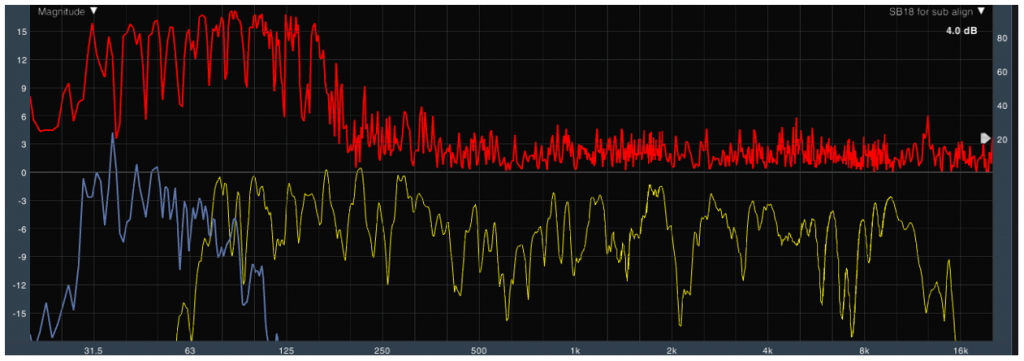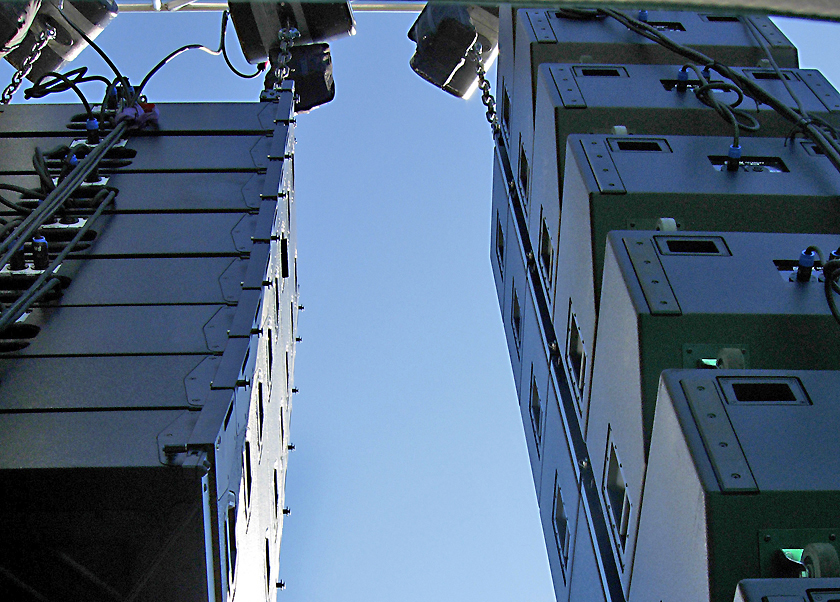I think most live mix engineers agree that a solid, thumping low-end response in pop and rock music is the standard and a preferred sonic outcome. However, the techniques we use to get that nice round sub bass low end are not always agreed upon.
The subject of low frequency “tilt” in PA systems is interesting in and of itself, and one that is discussed and debated increasingly by mix engineers and system specialists. Further, it’s dictated by many of the most popular sound system manufacturers today. When a modern line array PA system with complimentary subwoofers is deployed and the recommended system settings are recalled from its proprietary processor, the resulting frequency response is usually quite even from 20 kHz down to around 200 Hz, but then a substantial “tilt” occurs from 200 Hz and down.
I believe this built in low-end exaggeration is a “modern day default” from the manufacturers and designers to provide a fuller, rounder starting point based on studying many engineers’ final results after tuning sound systems for music. All one needs to do is visit a rock, pop, R&B (or EDM) music festival to hear the similarities in the sound system responses from stage to stage. There’s a lot of low-end going on, people!
Thunder On Demand
I also believe the tilt in the main loudspeakers (excluding subs) gives engineers and sound company owners the opportunity to provide PAs for smaller music events that don’t need subwoofers to produce a big, round sound. Leave the subs at the shop and lower the budget for the client while saving some truck space.
The merits and precautions of pre-building such a mountainous low-end tilt are well worthy of further debate and discussion in our industry. (See “The Right Tilt” for further discussion on this topic.)

But here, let’s go deeper (pardon the pun) and explore the following questions: “To tilt or not to tilt? And if so, how much?” For answers, I want to focus on the very critical crossover frequency area between the subs and the low-end of the main PA.
On my most recent tours with Matchbox 20, Peter Frampton, Journey, and Gwen Stefani, I’ve been experimenting with “un-tilting” the PA more and more, using the tools provided in modern sound system processors and software. These tools include Array Morphing provided with L-Acoustics amplifiers and LA-Network Manager software, Array Correction within the Meyer Compass/Galaxy, and the CPL tool provided with d&b Audiotechnik R1 software.
I appreciate that the “out of the box” thunder is still there if I want it; I’ve just been approaching things differently lately. I prefer to tame the big tilt in the speakers and reduce the sub bass level so that the amplitude of both low-end sources sits just a couple dB up from where the mids and highs are living. Then, to bring the overall mix back around to round and punchy, I add the low-end fullness back into the console mix.
It’s important to remember at this point that while tuning the PA with Rational Acoustics Smaart or your analyzer of choice, each loudspeaker array will contribute to the overall low-end tilt when added to the other arrays, so be mindful of low-end build up as the entire PA is pieced together to cover all the seats in the listening area. Of course, this includes subs.
I almost always start my tuning process with only one side of the main flown (or stacked) loudspeaker array. (Let’s assume we’re listening to house right.) If we begin with the default preset for this loudspeaker system in the processor and turn it up for evaluation, we’ll most likely find a pretty large tilt in the lower frequencies beginning around 500 Hz and rising continually as we descend down to the 60 – 50 Hz range.
My new approach is to tame down any substantial rise in the low-end when compared to where the mid and high frequencies are residing. With most systems, the trace, when viewed in Smaart’s Transfer Function mode, appears quite flat from 20 kHz on down to 60 Hz, with only the smallest tilt in the lower frequencies (200 Hz down to 60 Hz).

Taking It Further
The process continues with the addition of other arrays. When the house right subs are added to the house right mains, I set the level to “lock on” to the lowest frequencies of the main PA and add in only what is missing below that with similar amplitude. In most cases the subs have to be turned down quite a few dB from the suggested manufacturer default level, but this will be another big step in the battle against “over-tilting.”
After setting the individual main and sub levels for just one side of the PA, it’s a good idea to turn on and listen to both the mains and subs together. In doing so, we’ll probably hear (and see on Smaart) a rise in the overlapping frequencies between the lowest main frequencies and the highest sub frequencies. This is the “critical crossover” region.















